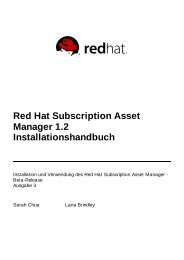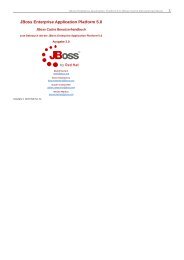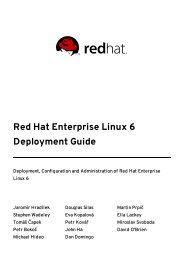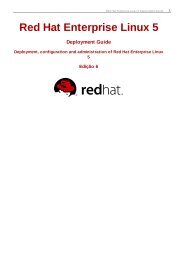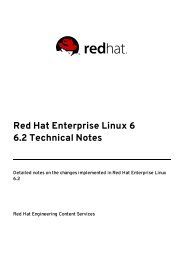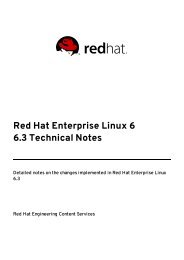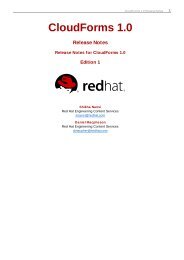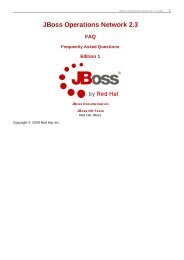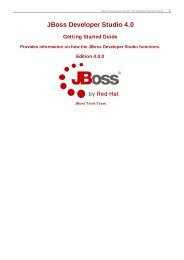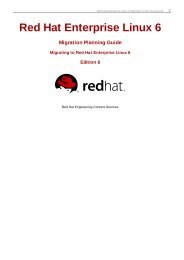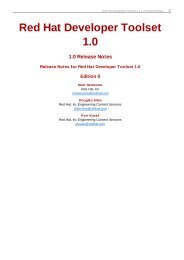- Page 1 and 2: JBoss Enterprise Application Platfo
- Page 3 and 4: Abstract JBoss Enterprise Applicati
- Page 5 and 6: JBoss Enterprise Application Platfo
- Page 7 and 8: JBoss Enterprise Application Platfo
- Page 9 and 10: JBoss Enterprise Application Platfo
- Page 11 and 12: Chapter 1. Introduction JBoss Enter
- Page 13 and 14: JBoss Enterprise Application Platfo
- Page 15 and 16: JBoss Enterprise Application Platfo
- Page 17 and 18: JBoss Enterprise Application Platfo
- Page 19 and 20: Chapter 4. Deployment Deploying app
- Page 21 and 22: web JBoss Enterprise Application Pl
- Page 23 and 24: Chapter 6. The JNDI Naming Service
- Page 25 and 26: JBoss Enterprise Application Platfo
- Page 27 and 28: JBoss Enterprise Application Platfo
- Page 29 and 30: JBoss Enterprise Application Platfo
- Page 31 and 32: JBoss Enterprise Application Platfo
- Page 33 and 34: Example 6.2. A JNDI client that use
- Page 35 and 36: JBoss Enterprise Application Platfo
- Page 37 and 38: JBoss Enterprise Application Platfo
- Page 39 and 40: JBoss Enterprise Application Platfo
- Page 41 and 42: JBoss Enterprise Application Platfo
- Page 43: JBoss Enterprise Application Platfo
- Page 47 and 48: JBoss Enterprise Application Platfo
- Page 49 and 50: JBoss Enterprise Application Platfo
- Page 51 and 52: JBoss Enterprise Application Platfo
- Page 53 and 54: @XmlAccessorType(XmlAccessType.FIEL
- Page 55 and 56: JBoss Enterprise Application Platfo
- Page 57 and 58: 7.15. WebServiceContext The WebServ
- Page 59 and 60: ** * The getPort method returns a p
- Page 61 and 62: Message Payload In this mode, clien
- Page 63 and 64: JBoss Enterprise Application Platfo
- Page 65 and 66: JBoss Enterprise Application Platfo
- Page 67 and 68: JBoss Enterprise Application Platfo
- Page 69 and 70: JBoss Enterprise Application Platfo
- Page 71 and 72: @WebServiceClient(name = "EchoServi
- Page 73 and 74: @WebService(name = "StatefulEndpoin
- Page 75 and 76: JBoss Enterprise Application Platfo
- Page 77 and 78: JBoss Enterprise Application Platfo
- Page 79 and 80: JBoss Enterprise Application Platfo
- Page 81 and 82: JBoss Enterprise Application Platfo
- Page 83 and 84: JBoss Enterprise Application Platfo
- Page 85 and 86: JBoss Enterprise Application Platfo
- Page 87 and 88: JBoss Enterprise Application Platfo
- Page 89 and 90: ** * Creates a Jaxr Organization wi
- Page 91 and 92: JBoss Enterprise Application Platfo
- Page 93 and 94: ** * Annotation for specifying the
- Page 95 and 96:
JBoss Enterprise Application Platfo
- Page 97 and 98:
JBoss Enterprise Application Platfo
- Page 99 and 100:
JBoss Enterprise Application Platfo
- Page 101 and 102:
JBoss Enterprise Application Platfo
- Page 103 and 104:
JBoss Enterprise Application Platfo
- Page 105 and 106:
that have not completed after a spe
- Page 107 and 108:
JBoss Enterprise Application Platfo
- Page 109 and 110:
JBoss Enterprise Application Platfo
- Page 111 and 112:
JBoss Enterprise Application Platfo
- Page 113 and 114:
JBoss Enterprise Application Platfo
- Page 115 and 116:
JBoss Enterprise Application Platfo
- Page 117 and 118:
Oracle 10g: org.hibernate.dialect.O
- Page 119 and 120:
JBoss Enterprise Application Platfo
- Page 121 and 122:
JBoss Enterprise Application Platfo
- Page 123 and 124:
JBoss Enterprise Application Platfo
- Page 125 and 126:
JBoss Enterprise Application Platfo
- Page 127 and 128:
JBoss Enterprise Application Platfo
- Page 129 and 130:
JBoss Enterprise Application Platfo
- Page 131 and 132:
JBoss Enterprise Application Platfo
- Page 133 and 134:
JBoss Enterprise Application Platfo
- Page 135 and 136:
JBoss Enterprise Application Platfo
- Page 137 and 138:
That's it; that's all it takes to g
- Page 139 and 140:
JBoss Enterprise Application Platfo
- Page 141 and 142:
JBoss Enterprise Application Platfo
- Page 143 and 144:
JBoss Enterprise Application Platfo
- Page 145 and 146:
Application Platform ships with a d
- Page 147 and 148:
JBoss Enterprise Application Platfo
- Page 149 and 150:
JBoss Enterprise Application Platfo
- Page 151 and 152:
JBoss Enterprise Application Platfo
- Page 153 and 154:
JBoss Enterprise Application Platfo
- Page 155 and 156:
JBoss Enterprise Application Platfo
- Page 157 and 158:
JBoss Enterprise Application Platfo
- Page 159 and 160:
JBoss Enterprise Application Platfo
- Page 161 and 162:
JBoss Enterprise Application Platfo
- Page 163 and 164:
ean. By default true, since replica
- Page 165 and 166:
a different physical host. If not a
- Page 167 and 168:
JBoss Enterprise Application Platfo
- Page 169 and 170:
JBoss Enterprise Application Platfo
- Page 171 and 172:
JBoss Enterprise Application Platfo
- Page 173 and 174:
JBoss Enterprise Application Platfo
- Page 175 and 176:
JBoss Enterprise Application Platfo
- Page 177 and 178:
JBoss Enterprise Application Platfo
- Page 179 and 180:
JBoss Enterprise Application Platfo
- Page 181 and 182:
JBoss Enterprise Application Platfo
- Page 183 and 184:
JBoss Enterprise Application Platfo
- Page 185 and 186:
JBoss Enterprise Application Platfo
- Page 187 and 188:
JBoss Enterprise Application Platfo
- Page 189 and 190:
JBoss Enterprise Application Platfo
- Page 191 and 192:
JBoss Enterprise Application Platfo
- Page 193 and 194:
JBoss Enterprise Application Platfo
- Page 195 and 196:
JBoss Enterprise Application Platfo
- Page 197 and 198:
deployment (war, ear, jar, whatever
- Page 199 and 200:
JBoss Enterprise Application Platfo
- Page 201 and 202:
JBoss Enterprise Application Platfo
- Page 203 and 204:
JBoss Enterprise Application Platfo
- Page 205 and 206:
JBoss Enterprise Application Platfo
- Page 207 and 208:
JBoss Enterprise Application Platfo
- Page 209 and 210:
JBoss Enterprise Application Platfo
- Page 211 and 212:
The available attributes in the FD
- Page 213 and 214:
JBoss Enterprise Application Platfo
- Page 215 and 216:
JBoss Enterprise Application Platfo
- Page 217 and 218:
JBoss Enterprise Application Platfo
- Page 219 and 220:
JBoss Enterprise Application Platfo
- Page 221 and 222:
JBoss Enterprise Application Platfo
- Page 223 and 224:
JBoss Enterprise Application Platfo
- Page 225 and 226:
JBoss Enterprise Application Platfo
- Page 227 and 228:
JBoss Enterprise Application Platfo
- Page 229 and 230:
JBoss Enterprise Application Platfo
- Page 231 and 232:
JBoss Enterprise Application Platfo
- Page 233 and 234:
import org.jboss.ha.cachemanager.Ca
- Page 235 and 236:
JBoss Enterprise Application Platfo
- Page 237 and 238:
JBoss Enterprise Application Platfo
- Page 239 and 240:
JBoss Enterprise Application Platfo
- Page 241 and 242:
JBoss Enterprise Application Platfo
- Page 243 and 244:
JBoss Enterprise Application Platfo
- Page 245 and 246:
Example A.10. Sybase Datasource [ 1
- Page 247 and 248:
JBoss Enterprise Application Platfo
- Page 249 and 250:
JBoss Enterprise Application Platfo
- Page 251 and 252:
JBoss Enterprise Application Platfo
- Page 253 and 254:
Example A.25. PostgreSQL XA Datasou
- Page 255 and 256:
Example B.2. Filtering App1 Log Out



